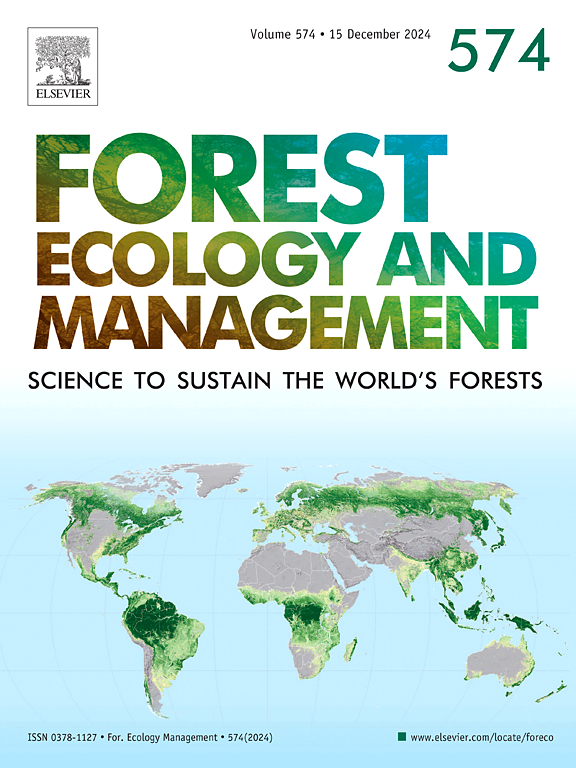Green is the New Black: Outcomes of post-fire tree planting across the US Interior West
IF 3.7
2区 农林科学
Q1 FORESTRY
引用次数: 0
Abstract
Reforestation activities such as tree planting are important management tools to offset carbon emissions and restore forest ecosystem integrity. Severe wildfire activity, a key driver of forest loss, is increasing throughout the western United States (US) and creating an immense backlog of areas needing reforestation. Major financial investments and recent policy changes are expected to accelerate rates of tree planting, yet the broad-scale impact and efficacy of post-fire planting activities remain poorly understood. We quantified the outcomes of recent (1987–2022) post-fire plantings in the US Interior West using remotely sensed estimates of forest cover change and in-situ survival records (69,245 seedlings) spanning 297 unique fire events. Overall, planted areas gained forest cover 25.7 % more rapidly than environmentally similar, unplanted sites in the same fires, and planted seedling survival averaged 79.5 % (SD = 23.2 %) after one growing season. However, the effects of planting were highly variable over time and across environmental gradients. Forest cover gain and planted seedling survival were typically highest in cold, wet areas and when planting was followed by wetter-than-average years. Planting season also shaped outcomes, with late summer or fall plantings performing best on warm, dry sites, and spring plantings performing best in cold, wet areas. Forest cover gain was fastest in planting units that burned at low to moderate severity and had > 20 % post-fire forest cover in the surrounding area. Nearly half of all plantings were completed in such areas, where natural regeneration processes are most likely to promote forest recovery even without intervention. Here, we demonstrate that tree planting can enhance post-fire forest recovery rates at broad scales, though its effects are dependent on a range of environmental and operational factors. Our results help inform realistic expectations of planting outcomes, an issue of global relevance as such projects expand to achieve restoration and climate mitigation goals.
绿色是新的黑色:美国西部内陆地区火灾后植树的成果
植树造林等重新造林活动是抵消碳排放和恢复森林生态系统完整性的重要管理工具。严重的野火活动是造成森林损失的主要原因,在整个美国西部,野火活动日益频繁,积压了大量需要重新造林的地区。大量的资金投入和最近的政策变化有望加快植树造林的速度,但人们对火灾后植树造林活动的广泛影响和效果仍然知之甚少。我们利用对森林植被变化的遥感估算和跨越 297 次独特火灾事件的原地存活记录(69,245 株树苗),量化了美国西部内陆地区近期(1987-2022 年)火灾后植树造林的成果。总体而言,在相同的火灾中,人工种植区的森林覆盖率增加速度比环境相似的未种植区快 25.7%,在一个生长季节后,人工种植幼苗的平均存活率为 79.5%(SD = 23.2%)。然而,植树造林的效果随时间和环境梯度的变化很大。在寒冷潮湿的地区,以及植树后比平均年龄更潮湿的年份,森林覆盖率和植树造林苗存活率通常最高。种植季节也会影响结果,夏末或秋季种植在温暖、干燥的地区表现最佳,而春季种植在寒冷、潮湿的地区表现最佳。森林覆盖率增长最快的是中低严重程度燃烧的种植区,其周边地区的火后森林覆盖率为 20%。近一半的植树都是在这些地区完成的,在这些地区,即使不进行干预,自然再生过程也最有可能促进森林恢复。在此,我们证明植树造林可以在很大范围内提高火灾后森林的恢复率,尽管其效果取决于一系列环境和操作因素。我们的研究结果有助于为植树造林成果的现实预期提供依据,随着植树造林项目的扩大以实现恢复和减缓气候变化的目标,这是一个具有全球意义的问题。
本文章由计算机程序翻译,如有差异,请以英文原文为准。
求助全文
约1分钟内获得全文
求助全文
来源期刊

Forest Ecology and Management
农林科学-林学
CiteScore
7.50
自引率
10.80%
发文量
665
审稿时长
39 days
期刊介绍:
Forest Ecology and Management publishes scientific articles linking forest ecology with forest management, focusing on the application of biological, ecological and social knowledge to the management and conservation of plantations and natural forests. The scope of the journal includes all forest ecosystems of the world.
A peer-review process ensures the quality and international interest of the manuscripts accepted for publication. The journal encourages communication between scientists in disparate fields who share a common interest in ecology and forest management, bridging the gap between research workers and forest managers.
We encourage submission of papers that will have the strongest interest and value to the Journal''s international readership. Some key features of papers with strong interest include:
1. Clear connections between the ecology and management of forests;
2. Novel ideas or approaches to important challenges in forest ecology and management;
3. Studies that address a population of interest beyond the scale of single research sites, Three key points in the design of forest experiments, Forest Ecology and Management 255 (2008) 2022-2023);
4. Review Articles on timely, important topics. Authors are welcome to contact one of the editors to discuss the suitability of a potential review manuscript.
The Journal encourages proposals for special issues examining important areas of forest ecology and management. Potential guest editors should contact any of the Editors to begin discussions about topics, potential papers, and other details.
 求助内容:
求助内容: 应助结果提醒方式:
应助结果提醒方式:


